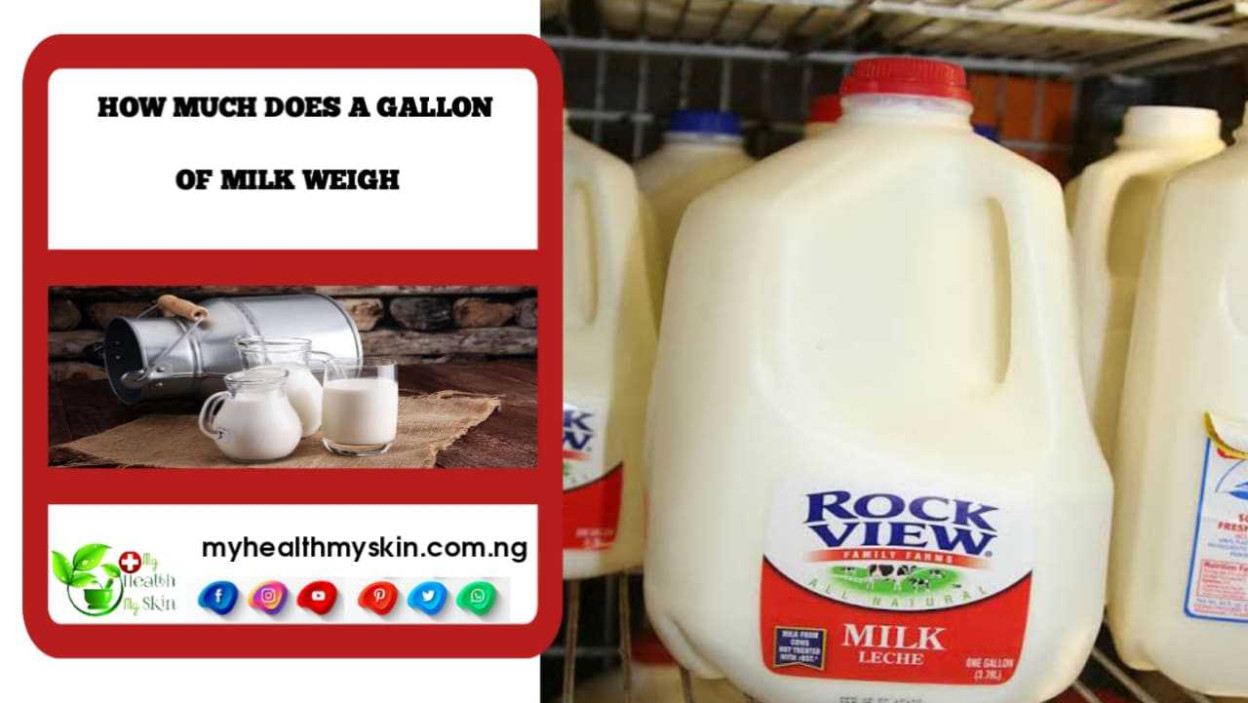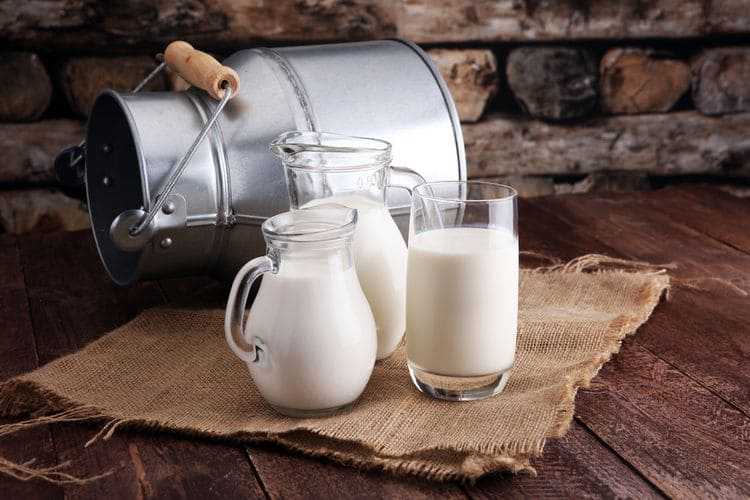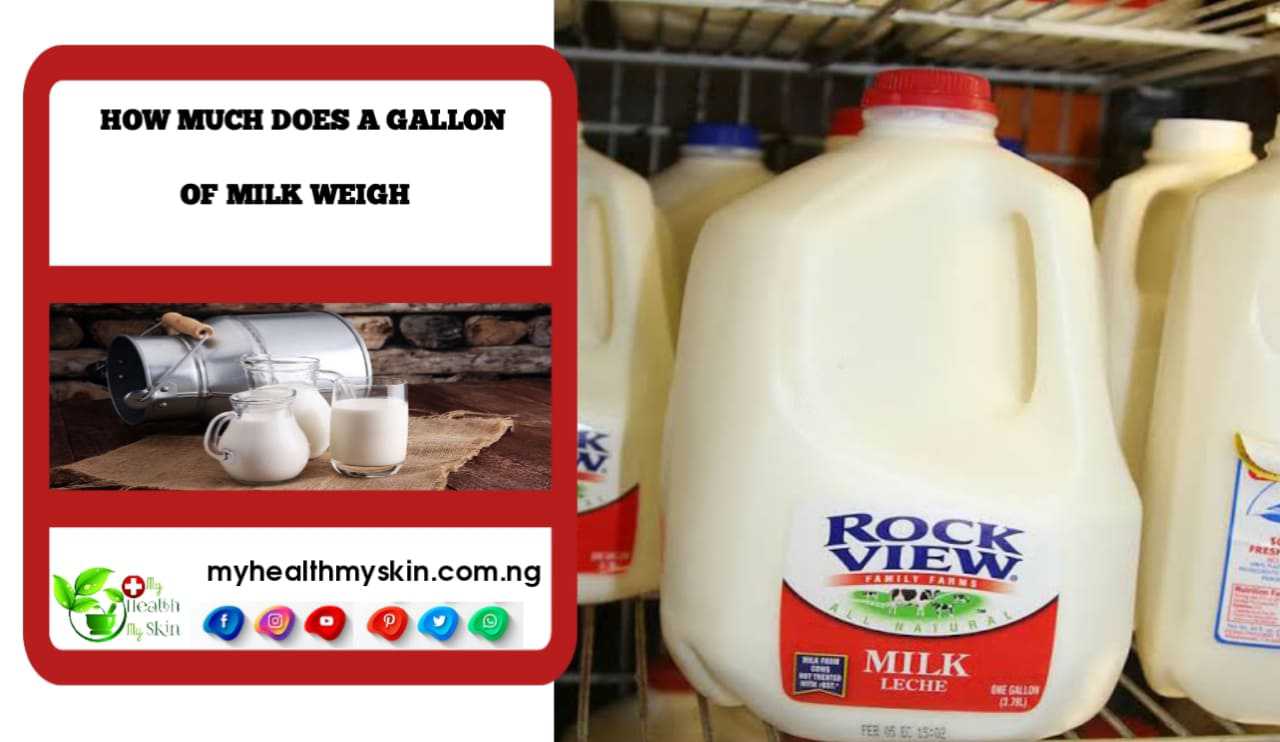How much does a gallon of milk weigh? If this is your question then you are on the right page to get your answer.
As is known, milk is an organic product, so the amount a gallon of milk weigh are average rather than exact numbers. Depending on its fat and nutrient content, the weight of milk may vary slightly.
According to Normative Instruction 76, of November 26, 2018, milk must have the following characteristics in its composition:
- 3% fat
- 2.9% protein
- 4.3% lactose
- 8.4% non-fat solids (all elements of milk except fat and water)
- 11.4% total solids (all elements in milk except water)
Due to its properties and nutritional values, dairy products seek to acquire milk with higher values of solids, especially fat and protein. For this, many industries have already adopted payment tables for quality and composition, which give bonuses and pay a better price to producers who produce milk with higher quality and quantity of solids.
Check out how much does a gallon of milk weigh? Additionally, find some other frequently asked questions about weight of milk gallon in this health blog.
[lwptoc]
What A Gallon Of Milk Weighs?
Milk can also be weighed based on its fat content: whole milk (3.25% milk fat), reduced-fat milk (2%), and low-fat milk (1%). Milk can be processed and packaged in so may ways. It can be presented in liquid, powder or emulsion form. As for the packaging of milk, the most common is that of gallons.
How Much Does a Gallon of Milk Weigh?
In the US, a gallon of milk weighs approximately 8.6 lbs (3.9kg). In the United Kingdom or Canada, a gallon of milk weighs 10.3 lbs (4.67kgs).
Of course, since milk is an organic product, those numbers are averages rather than exact numbers. Depending on its fat and nutrient content, the weight of milk can vary a small amount. For reference, the weight of a gallon of water is 8.34 pounds, and the density of water is approximately 1 kilogram per liter. Since milk is 80 to 90 percent water, even a gallon milk sample of outliers varies by only a few ounces from the USDA figure. Also, since most commercially sold milk is blended and homogenized, the chance of significant variation is even less.
What About the Fat Content of Milk?
Milk is approximately 87% water and 13% total solids, which includes fat, protein, lactose, vitamins and minerals. These elements constitute the nutritional value of milk and may vary according to milk type, production level, lactation stage, diseases, among other factors.
The fat content in milk varies widely in weight. Whole milk generally contains about 3.35 percent fat. Low-fat milk contains at least one percent fat.
Meanwhile, skim milk contains only 0.5 percent fat. Many people avoid whole milk because of its high saturated fat content. According to Healthline, excessive consumption of saturated fats can increase the risk of heart disease. Research also proves that saturated fat intake can increase cholesterol levels in the body.
A cup of whole milk usually contains 4.6 grams of saturated fat, which is 20 percent of the recommended daily amount. That’s why skimmed milk or low-fat milk is claimed to be healthier. However, this is still being debated because some experimental data state that consumption of saturated fat cannot increase the risk of heart disease.
Things you should know when Weighing a Gallon of Milk
The most common way to weigh milk is in its liquid form. There are other forms of milk, such as powdered milk, but they are not as easy to measure as liquid milk. This is because milk in a liquid state is easy to pack and weigh. There are different ways to package liquid milk. It can be packaged in plastic jars, in cardboard boxes, etc.
The liquid form of milk is the best way to measure weight, because the milk will take on the volume and shape of the container, so you can easily measure it correctly. You may measure two different gallons of milk and get different weights, this could be due to the type of milk.
There are different types of dairy products depending on their fat content, whole milk (it is the one with the highest milk content), reduced-fat milk, low-fat milk and fat-free milk. The fat content in milk provides a little to the weight. The difference is not much, maybe 0.2 pounds. Aside from the plastic gallon, there are other ways to measure milk. These different shapes are seen all the time.
Different ways of weighing milk
Weighing milk is not difficult at all. The weight of milk depends on the size of the container that contains it. If you put milk in a cup, the weight of the milk will be the weight of the cup with the milk in it. So, these are some of the most common containers used to pack milk and their respective weights.
If you go to the store to buy milk, some of the common containers used to measure it are cartons, boxes, glasses, gallons, and others.
- Cardboard box: It is one of the most common ways to package milk. You’ll likely see a carton at every grocery store you go to. The size of the milk carton can vary by manufacturer, and the amount of milk it contains can also vary by brand. This can affect the total weight and make two milk cartons of the same size weigh differently. The milk carton can also vary in volume, it can be 1 liter or 2 liters, or even half a liter. The volume will dictate the weight of the milk.
- Bottle: Another way to measure the weight of milk is with bottles, although this packaging method is not as common as it used to be. You can pack the milk in glass bottles and measure it. The weight of the milk will also depend on the amount of milk that the bottle can hold or the volume of the bottle.
- Plastic Gallon: This is another common and trending way to measure milk. You can use a gallon, which is equivalent to about 4-5 liters. A gallon of milk weighs 8.6 pounds.
It is possible to weigh milk using the same method and arrive at different weight values. This may be because the amount of milk in the containers is different, or because one of the containers has a slight difference in volume.
Why Milk Weight Varies by Country
The weight of a US gallon of milk will vary slightly depending on the density of the liquid, but will typically be around 8.6 pounds. Changes in the fat content of the milk will make the gallon weigh slightly more or less.
The US gallon equals about 3.79 liters. There are also other units called “gallons”. The imperial gallon, which is used in the United Kingdom, Canada, and some Caribbean countries, is around 4,546 litres. The US dry gallon, equivalent to about 4.4 liters, is rarely used. US and Imperial dry gallons will weigh more than the standard US gallon.
In an effort to provide healthier substitutes for traditional whole milk, some dairy producers skim a portion of the fat content before packaging it as low-fat or 2 percent milk. This removed portion is sometimes used to make milk products such as cheese and cream. Due to the missing fat and the fact that milk is about 87 percent water, skim milk generally has a thinner consistency and waterier taste.
What Are Factors That Affect Milk Weight?
Check out some factors that can influence the weight of milk, composition, increasing or reducing the solids content:
1. Genetics:
The breed of the animals is directly related to the solids content in the milk. An example is the Jersey breed, which produces fat content that can vary from 4 to 6%, while Holstein cows produce milk with a fat content between 3 to 3.8%. The same occurs with protein and mineral contents, which are higher in the Jersey breed.
2. Lactation stage:
Colostrum, which is the first milk secreted after childbirth, differs from milk from the rest of lactation, as it contains a high content of total solids and a large amount of immunoglobulins. During the first three months of lactation, the amount of protein and fat is lower, and as lactation approaches the end, these levels increase.
3. Lactation order:
First-calf cows produce milk with a higher amount of solids, and from the second calf onwards, this amount decreases.
4. Nutritional management:
Fat is the component with the greatest variation in milk content, and is the most influenced by food. Diets high in fiber, good quality fiber and adequate particle size increase milk fat production. The supply of smaller amounts of concentrate as well, since the greater amount of fiber is related to the production of acetate in the rumen, which is a precursor of milk fat.
In the case of protein, manipulation through nutritional management is not as expressive, since the increase that occurs in the protein content is small, if compared to the fat. The variation is from 0.1 to 0.4% only. Furthermore, the mechanisms that promote an increase in protein content are, for the most part, opposite to those that promote an increase in fat content.
To be successful with nutritional management, it is necessary to take care of the comfort of the animals, especially the thermal comfort. In the hottest seasons of the year, cows suffer from the heat and enter heat stress, which causes a considerable decrease in feed intake. This decrease in consumption also affects the production of solids, especially the production of fat.
5. Mastitis:
Mastitis is an inflammation of the mammary gland caused by microorganisms, mainly bacteria. In addition to reducing production, mastitis also interferes with the composition of milk. Mastitis causes a reduction in the levels of lactose, casein (which is the main protein in milk), fat and alters the concentration levels of minerals.
The composition of milk is not influenced by just one factor, but by many, and therefore changing it is not an easy task. If you want a milk with higher amounts of solids, start by choosing good genetics and handle them in the best possible way, providing health and comfort for the animals.
British or imperial gallon vs international or US gallon
Originating from the gallon of beer, Great Britain adopted this system of measurement in 1824, based on the weighted volume in air of 10 pounds of distilled water at 62ºF, that is, 16.667ºC, its barometric pressure being 30 inches of mercury. This resulted in a volume per gallon of 277.41945 cubic inches (one cubic inch equals 16.387064 cm3).
On the other hand, in the United States a similar measure was adopted, but based on the gallon of wine. Currently the international gallon measures 231 cubic inches.
How much does a British gallon weigh and how much does a US gallon weigh?
More specifically, one British or Imperial gallon is equal to:
- 4.5460902819948 liters
- 4 british quarters
- 8 British pints
- british 32 gills
- 160 British fluid ounces
- 0.028571428571429 British barrels
Regarding a US or international gallon, it has a value of:
- 3.785411784 liters
- 4 US quarters
- 8 US pints
- 32 US gills
- 128 US fluid ounces
- 0.0238095238095240 US barrels
Despite the differences in weight between one and the other, curiously both gallons are worth 8 pints. This is because pints in the US equal 16 ounces and in the UK 20.
Final thoughts
Milk contains different nutrients that are important for the development of the organism. That is why it is necessary that all newborns drink milk during the first six months of development. Of course, breast milk is not the same as other forms of milk, but it still contains some of the important nutrients found in other forms.
Normal milk contains compounds such as lipids, which refers to the fat component. It is made up of triacylglycerols and phospholipids.
Milk also contains proteins, caseins, calcium from the calcium phosphate structure, salts, minerals and vitamins, sugar and some carbohydrates.
Milk is an important part of meals as it contains different components that are important for our development. It is also a very crucial component for the development of babies. Milk contains nutrients such as calcium, necessary for bone development. It also contains proteins, lipids or fats, and vitamins.
The best way to measure the weight of milk is in liquid form and using containers with a known weight. The most common containers used to store milk are cartons, gallons, and bottles. The weight of milk in each of them depends on the volume of the containers.
FAQs
How much does a gallon of milk weigh in pounds?
According to the USDA, a gallon of milk weighs about 8.6 pounds. A liter of milk weighs about 2.15 pounds.
You can try to measure milk by yourself to confirm, but there are some factors that may cause weight deviation. Below we will look at the fat content in milk and many other things.
How much does 1 liter of milk weigh?
Milk has a density of 1.03 kg/l, so a liter of milk weighs 1030 grams.
How many pounds is a quart?
Pounds to US Quarts (Liquid) Table
| Pounds | US quarts (liquid) |
|---|---|
| 1lb | 0.48080791216702 US qt lqd |
| 2 lbs. | 0.96161582433404 US qt lqd |
| 3 lbs. | 1.4424237365011 US qt lqd |
| 4 lbs. | 1.9232316486681 US qt lqd |
What is the weight of gallons in the United States?
Despite the differences in weight between one and the other, curiously both gallons are worth 8 pints. This is because pints in the United States equal 16 ounces and in the United Kingdom 20. An example of the common use of gallons is in the gasoline product. Drivers buy gasoline by the gallon in the United States.
What is the weight of an international gallon?
Currently the international gallon measures 231 cubic inches. Despite the differences in weight between one and the other, curiously both gallons are worth 8 pints. This is because pints in the United States equal 16 ounces and in the United Kingdom 20. An example of the common use of gallons is in the gasoline product.
What types of gallons are there?
There are two types of gallons: the imperial or British and the international or American. Used in Canada, the US, Puerto Rico, Colombia, among others, the gallon can be seen on all product labels from these countries.
What is a gallon of beer in Britain?
Originating from the gallon of beer, Great Britain adopted this system of measurement in 1824, based on the weighted volume in air of 10 pounds of distilled water at 62ºF, that is, 16.667ºC, its barometric pressure being 30 inches of mercury. .
How much milk do we weigh in the kitchen?
We can estimate that a liter of milk weighs as much as a liter of water, but in the kitchen, you have to be accurate. The answer is therefore 1030g. Whole milk has a density of 1.03 kg.
How much does a liter of milk weigh for making yoghurts?
For milk, which is necessary for making yogurts, you need to know how much a liter of milk weighs. We can estimate that a liter of milk weighs as much as a liter of water, but in the kitchen, you have to be precise. The answer is therefore 1030g. Whole milk has a density of 1.03 kg.
How many grams is equal to 1 gram?
1 Ml = 1 Gr (1 milliliter is equal to 1 gram) so for example: 300Ml = 300 grams We sincerely hope that all this will be useful to you.
How can i calculate the average mass of a liter of milk?
The weight of a liter of milk is 1030 grams, it is calculated from the density of milk , which is 1030g/l. 1 liter of milk = 1030 grams.
How much does 1 liter of water weigh?
1 kg The mass of a liter of pure water is 1 kg Another liquid or a mixture has a different mass. This simple result is no coincidence. Historically the kilogram was defined as the mass of one liter of pure water.
How to make 25 cl of milk?
25cl is 250ml so 1 tablespoon more than 1 cup.
How to measure 30 cl of milk without a measuring cup?
Just divide the ml by 10, to get cl . Example: 300 ml of milk / 10 = 30 cl of milk.
How to go from ml to kg?
But above all, we can remember that 1 L of water (volume) – ie 1,000 ml or 100 cl – weighs 1 kg (mass) or 1,000 g. This liquid is used as a principle to define many scientific units.
How to convert 25 cl to grams?
Conversions are practical and simple in order to make your recipe successful including (cl to g, cl to ml, ml to cl, cl to oz, cl to spoonful, cl to liter etc.) Check out the conversions below with respect to liquids and solid….
| Conversion centiliter to gram ( cl to g ) | |
|---|---|
| 1 cl = | 10 g |
| 25 cl = | 250 g |
| 30 cl = | 300 g |
| 40 cl = | 400 g |
Gasoline in gallons or liters
An example of the common use of gallons is in the gasoline product. Drivers buy gasoline by the gallon in the United States. However, Canadians and Europeans do it by the liter. Likewise, Americans measure fuel efficiency in miles per gallon, while Europeans measure it in kilometers per liter.
We hope this article helped you learn how much does a gallon of milk weigh? You may also want to learn How Many Liters In A Gallon: Convert 1 Gallons To Litres, or check out our measurement category.
If you liked this article, then please share on your social networks and stay tuned for upcoming articles. You can also find us on Telegram and Facebook.










